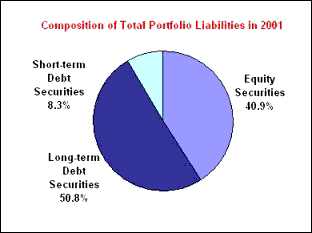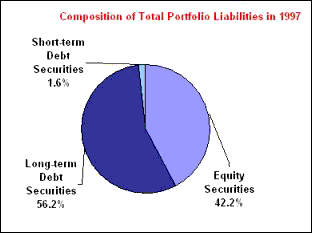The International Monetary Fund has recently published its second global survey of portfolio investment. This study, titled "Coordinated Portfolio Investment Survey" (CPIS), collected data on cross-border holdings of equity and debt securities in 67 economies in 2001. The first CPIS survey was conducted in 1997 and according to the IMF website, starting with the 2001 survey, the CPIS will be carried out annually. The CPIS seeks to provide comprehensive global information on cross-border ownership of securities. The CPIS results include securities held by portfolio investors (including monetary authorities) but exclude securities held by direct investors--those which hold a minimum of 10 percent of the shares of the entity that issues the securities.
CPIS shows that no developing country is among the top 20 recipients of portfolio investment in 2001. Top twenty recipients, all of whom are developed countries, account for more than 91 percent of total portfolio liabilities. Remaining 218 countries account for the other nine percent. The concentration of portfolio investment becomes even more evident from the fact that top 10 countries hold about 74 percent of total portfolio liabilities.
These findings are interesting because since the late 1980s and early 1990s, multilateral institutions like the World Bank and the International Monetary Fund (IMF) actively encouraged developing countries to open up their economies to attract portfolio capital inflows. In fact, one of the essential components of the Structural Adjustment programme imposed by the IMF during the late 1980s was widespread liberalization of the financial sector of developing countries and removal of restrictions on foreign investors' entry into the domestic economies of these countries. As a result, a number of developing countries initiated sweeping liberalization in their domestic economic system to attract foreign portfolio investment. Initially, portfolio investors responded positively to these developments and significant amount of foreign portfolio investment came into these countries. But the spate of financial crisis that surfaced in the developing countries during the late 1990s has changed the situation completely.
The relative decline of portfolio investment as a source of private capital flow will be evident from the following figure. Time series data from IMF's World Economic Outlook show that net private portfolio investment flow to emerging markets accounted for 64.5 percent of total private capital flow in 1994, however, after 2000, these countries are experiencing net outflow of private portfolio investment flow (Figure 1).
 |
According to CPIS 2001, cross-border holdings of portfolio investment reached US$12.5 trillion in the 67 economies in 2001. Of the total cross-border holdings reflected in the survey, US$5.1 trillion was in equity securities and US$7.4 trillion in debt securities. Data also show that compared to 1997, there is a significant shift towards short term debt securities in 2001. From 1.6 percent of total portfolio investment in 1997, the share of short term debt increased to 8.3 percent in 2001 (figure 2).
 |
 |
The survey results also reveal that total stock of portfolio liabilities has more than doubled from US$ 6.1 trillion in 1997 to US$ 12.5 trillion in 2001. However, if the reported countries are divided into developed and developing countries [1], it shows that stocks of portfolio investment in developed countries have grown much faster than those in the developing ones (Table 1). In fact, in more than 50 developing countries there has been a net outflow of portfolio investment during the period 1997-2001. As a consequence, after 1997, share of developing countries in total portfolio liabilities has gone down quite significantly (Table 1).
| Table 1 | ||||
|
Portfolio Liabilities (in US$ Trillion) |
Share in Total Portfolio Liabilities (%) | |||
| Year | 1997 | 2001 | 1997 | |
| Developed Countries | 11.92 | 11.92 | 91.13 | 94.95 |
| Developing Countries | 0.63 | 0.63 | 8.87 | 5.05 |
| Total | 12.55 | 12.55 | 100.00 | 100.00 |
The sudden reversal and decline in portfolio investment is noteworthy
because since the late 80s, financial systems of most of developing countries
have moved from a bank-based system to a more stock market based system.
The reverse flow of portfolio investment is likely to have serious repercussions
on the economy of these countries. Secondly, recent researches, including
one
study from the IMF, are providing overwhelming evidence that portfolio
investment and increased financial globalization has not benefited growth
in developing countries. On the contrary, increased financial integration
has increased the vulnerability of these economies by exposing their economies
to the volatilities of short term capital flows. The results of this survey
clearly show that the shift of focus of portfolio investors has moved
away from most of the developing countries. Though portfolio investment
has grown more than 100 percent between 1997 and 2001, most of the new
investments are going to the developed countries. CPIS shows that developing
countries and emerging markets are no longer attractive destinations.